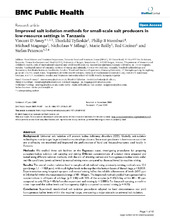Improved salt iodation methods for small-scale salt producers in low-resource settings in Tanzania
Assey, Vincent Didas; Tylleskär, Thorkild; Momburi, Philip B.; Maganga, Michael; Mlingi, Nicholaus; Reilly, Marie; Greiner, Ted; Peterson, Stefan
Peer reviewed, Journal article
Published version
Permanent lenke
https://hdl.handle.net/1956/3721Utgivelsesdato
2009-06-17Metadata
Vis full innførselSamlinger
Originalversjon
https://doi.org/10.1186/1471-2458-9-187Sammendrag
Background: Universal salt iodation will prevent iodine deficiency disorders (IDD). Globally, salt-iodation technologies mostly target large and medium-scale salt-producers. Since most producers in low-income countries are small-scale, we examined and improved the performance of hand and knapsack-sprayers used locally in Tanzania. Methods: We studied three salt facilities on the Bagamoyo coast, investigating procedures for preparing potassium-iodate solution, salt spraying and mixing. Different concentrations of solution were prepared and tested using different iodation methods, with the aim of attaining correct and homogeneous iodine levels under real-life conditions. Levels achieved by manual mixing were compared to those achieved by machine mixing. Results: The overall median iodation level in samples of salt iodated using previously existing methods was 10.6 ppm (range 1.1 – 110.0 ppm), with much higher levels in the top than the bottom layers of the salt bags, p < 0.0001. Experimentation using knapsack-sprayers and manual mixing led to the reliable achievement of levels (60.9 ppm ± 7.4) that fell within the recommended range of 40 – 80 ppm. The improved methods yielded homogenous iodine concentrations in all layers of salt-bags (p = 0.58) with 96% of the samples (n = 45) falling within 40 – 80 ppm compared to only 9% (n = 45) before the experiment and training (p < 0.0001). For knapsack-spraying, a machine mixer improved the iodine levels and homogeneity slightly compared to manual mixing (p = 0.05). Conclusion: Supervised, standardized salt iodation procedures adapted to local circumstances can yield homogeneous iodine levels within the required range, overcoming a major obstacle to universal salt iodation.
